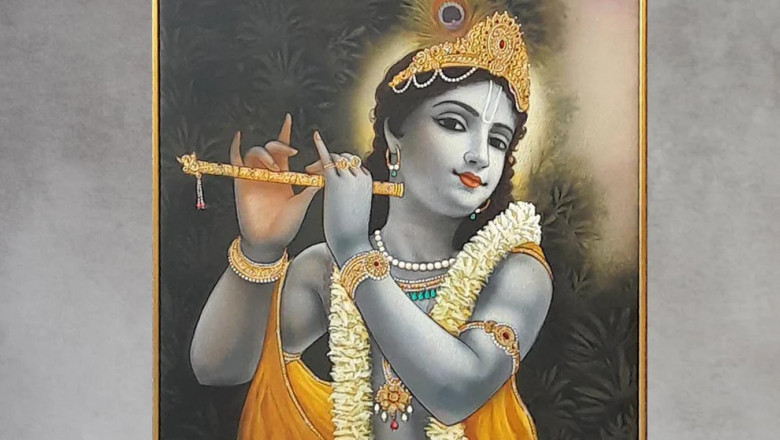views
Indian paintings are more than just expressions of creativity; they are profound reflections of the country's spirituality, philosophy, and culture. Across centuries, Indian paintings and art have seamlessly merged devotion with beautiful visuals, creating works that move beyond canvas into the realms of storytelling, symbolism, and transcendence. Faith and beauty have always coexisted in India, shaping not only the visual language of its people but also their deeper sense of identity.
A Historical Overview
The relationship between spirituality and art in India dates back thousands of years. Early evidence of this spiritual art can be found in the prehistoric cave paintings of Bhimbetka, where we can find depictions of rituals and sacred practices.
As Indian lifestyle evolved, so did its artistic expressions. The Indus Valley civilisation, though largely secular in its discovered relics, showcased a keen sense of symmetry and symbolism. Later, the Maurya and Gupta periods laid the foundation for spiritual art as we recognise it today. The Ajanta and Ellora caves, adorned with elaborate paintings and sculptures, depicted scenes from the life of Buddha and other divine beings, showcasing both artistic finesse and devotional depth.
During medieval times, temple architecture and sculpture reached new heights, with intricate carvings and vivid murals becoming essential parts of sacred sites, offering worshippers not just places of prayer but immersive experiences of faith.
Depiction of Divinity: Gods, Goddesses, and Sacred Narratives
In Ancient Indian paintings, gods and goddesses are more than figures; they are embodiments of ideals, virtues, and cosmic principles. Artists across centuries have portrayed deities not just as objects of worship but as dynamic characters with rich emotional and symbolic dimensions.
In the Ajanta Caves, murals capture the life of Buddha with an emotional depth that draws viewers into his spiritual journey. The vibrant miniature paintings from Rajasthan and Pahari regions bring stories from the Ramayana and Mahabharata to life, depicting battles, devotion, and divine play with vivid detail.
Tanjore paintings, known for their rich colours and gold leaf detailing, offer a resplendent vision of deities like Krishna, Lakshmi, and Shiva, blending devotion with opulence. These spiritual paintings were not just for temples but also adorned homes, turning private spaces into sanctuaries of faith.
Aesthetics Rooted in Philosophy and Devotion
The beauty in Indian art painting is not accidental; it is deeply rooted in aesthetic philosophy, particularly the concept of rasa, the emotional flavour or essence evoked in the observer.
Sacred paintings are aimed at stirring emotions like awe, devotion (bhakti), love, and peace, guiding the viewer toward a spiritual experience. Art became a tool not just for representing divinity but for invoking it.
The Bhakti movement, which swept across India between the 7th and 17th centuries, further deepened this connection. Artists, inspired by personal devotion rather than ritualistic practices, created works filled with emotional intensity. Krishna flute painting, often portrayed in tender moments with Radha, became a symbol of divine love accessible to all.

Symbolism played a vital role: lotuses symbolised purity; halos represented divine light; and specific hand gestures (mudras) conveyed protection, blessings, or teaching. Through these motifs, Indian classical paintings communicated profound spiritual messages without relying solely on words.
Regional Variations in Indian Paintings
India's vastness ensures that sacred art varies widely across regions, each offering a unique blend of devotion and aesthetic language.
In South India, temple murals in places like Chidambaram and Madurai burst with vibrant depictions of deities and mythological events. Intricate bronze sculptures of Nataraja (the cosmic dancer) illustrate the union of movement, form, and divine energy.
In East India, Pattachitra paintings from Odisha showcase tales of Lord Jagannath and Vishnu, using bold lines and a restricted colour palette to convey devotion with striking simplicity. Meanwhile, Bengal's Kalighat paintings brought deities into everyday contexts, making spiritual art accessible to the masses.
Folk art like Madhubani paintings from Bihar and Warli paintings from Maharashtra depicted local deities and rituals with minimalistic yet profound artistry, proving that divinity finds expression in both grandeur and simplicity.
Conclusion
The intersection of spirituality and aesthetics in Indian paintings and other art forms is not just a historical accident; it is a living testament to the Indian spirit that seeks beauty in devotion and devotion in beauty. Sacred narratives have given Indian art its emotional depth, philosophical richness, and timeless appeal.
If you are interested in bringing a piece of Indian art history for your living room, you should definitely check out Satguru’s. They are one of the best decor shops in Mumbai, known for their beautiful painting collection. Here, you can buy Indian traditional paintings, spiritual paintings, and modern paintings. From Ganesha wall paintings to abstract art, Satguru’s is your one-stop destination for amazing canvas art. Shop Now



















![[1 (888) 326-1024] How to Get in Touch with Expedia 24/7 Support Team: Phone, Email, and Chat Options](https://timessquarereporter.com/upload/media/posts/2025-06/01/1-888-326-1024-how-to-get-in-touch-with-expedia-24-7-support-team-phone-email-and-chat-options_1748757002-s.jpg)


Comments
0 comment